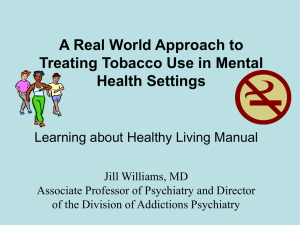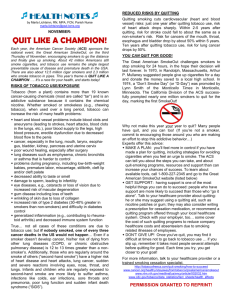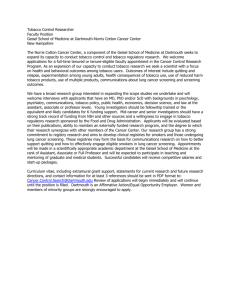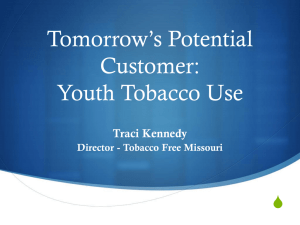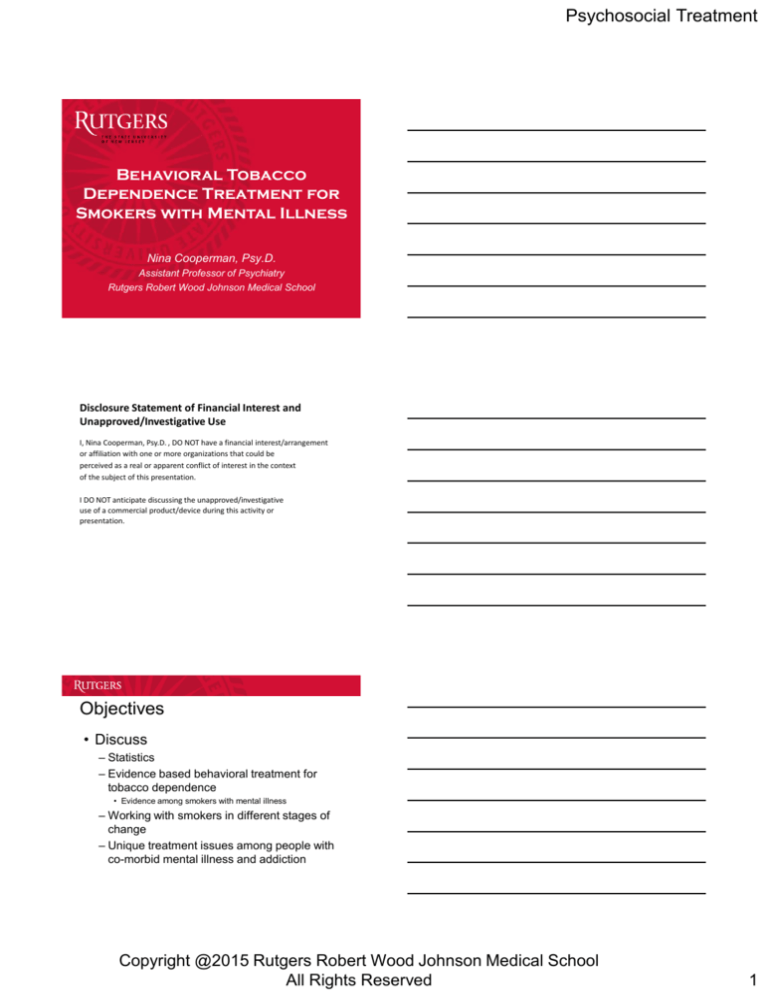
Psychosocial Treatment
Behavioral Tobacco
Dependence Treatment for
Smokers with Mental Illness
Nina Cooperman, Psy.D.
Assistant Professor of Psychiatry
Rutgers Robert Wood Johnson Medical School
Disclosure Statement of Financial Interest and
Unapproved/Investigative Use
I, Nina Cooperman, Psy.D. , DO NOT have a financial interest/arrangement
or affiliation with one or more organizations that could be
perceived as a real or apparent conflict of interest in the context
of the subject of this presentation.
I DO NOT anticipate discussing the unapproved/investigative
use of a commercial product/device during this activity or
presentation.
Objectives
• Discuss
– Statistics
– Evidence based behavioral treatment for
tobacco dependence
• Evidence among smokers with mental illness
– Working with smokers in different stages of
change
– Unique treatment issues among people with
co-morbid mental illness and addiction
Copyright @2015 Rutgers Robert Wood Johnson Medical School
All Rights Reserved
1
Psychosocial Treatment
General Population 17.8%
Prevalence of Smoking Not
Decreasing in those with Serious
Mental Illness
SAMHSA CBHSQ Report; July 18, 2013
Smokers with Behavioral
Health Comorbidity (Mental
Illness and Addiction) are
Becoming a Sizeable
Percentage of Smokers Left
in the US
Copyright @2015 Rutgers Robert Wood Johnson Medical School
All Rights Reserved
2
Psychosocial Treatment
Three Fourths of Smokers have a Past
or Present Problem with
or Addiction
Mental Illness
Lasser et al., 2000; Data from National Comorbidity Study
Persons with
a mental
disorder
or SUD
purchase
& consume
30-44%
of cigarettes
sold in the
US
50
45
40
35
30
25
20
15
10
5
0
Past month MI Nic dep and MI estimate no
and SUD
MI (NESARC; SUD (NSDUH;
(NCS; Lasser Grant 2004) MMWR 2013)
2000)
Smokers Suffer Financial
Consequences and Lower
Quality of Life
Food
Shelter
Misc. Living
Expenses
73%
N=68 smokers
with
schizophrenia
on disability
income
27%
Cigarettes
Steinberg ML, et al. Tobacco Control, 2004.
Copyright @2015 Rutgers Robert Wood Johnson Medical School
All Rights Reserved
3
Psychosocial Treatment
70
60
Smokers with Behavioral Health
Comorbidity are a Tobacco
Disparity Group
50
40
30
20
10
0
Williams et al., AJPH, 2013
Reduction in CVD (%) from Each
Risk Factor
70
60
50
40
30
50% of deaths in
schizophrenia, depression
and bipolar disorder
attributed to tobacco
Callaghan et al., 2013
20
10
0
SBP/ 5
10%
↓ 10mm
↓Cholesterol
mm DBP
20 min daily
walk/ exercise
Maintain ideal
body weight
Smoking
Cessation
Hennekens CH. Circulation. 1998;97:1095-1102
Tobacco in the
Environment
• 60% of mental health
consumers report living with
smokers AND smoking indoors
• Part of mental health culture
• Staff tobacco use
Williams et al., 2010 ; McNeill 2001
Copyright @2015 Rutgers Robert Wood Johnson Medical School
All Rights Reserved
4
Psychosocial Treatment
Mental health and chemical dependency counselor
Joan Ayala. Joan has a dual diagnosis of mental
illness and addiction. During her lifelong battle she
has learned coping skills to sustain her and end her
addiction and cope with her mental illness.
USA TODAY; December 22, 2014
Tobacco Use May Worsen
Behavioral Health
Outcomes
and
Cessation Doesn’t Worsen
BH Outcomes
Improved Mental Health with
Quitting Smoking
• Meta-analysis 26 studies (14 gen pop, 4 psychiatric, 3 physical
conditions, 2 psychiatric or physical, 2 pregnant, 1 post-op)
Taylor et al, BMJ, 2014
Copyright @2015 Rutgers Robert Wood Johnson Medical School
All Rights Reserved
5
Psychosocial Treatment
Behavioral Health Should Take
a Lead in Tobacco Treatment
• High prevalence of tobacco
use/ patient need
• Tobacco Dependence in DSMV
• Trained in addictions
• Tobacco interactions with
psych meds
• Longer and more treatment
sessions
• Experts in counseling
• Relationship to mental
symptoms and other
addictions
• Undervalue tobacco use as a
problem
• Consumers/ families minimize
the health risks of tobacco
• Professionals/ systems have
been slow to change in
addressing tobacco
• Lack the knowledge about
effectiveness of treatment
• Lack of advocating for
treatment
• Poor reimbursement
• Higher smoking among staff
READINESS to QUIT in SPECIAL
POPULATIONS
Intend to quit in next 6 mo
General Population
40%
General Psych Outpts
43%
Depressed Outpatients
Intend to quit in next 30 days
20%
55%
Psych. Inpatients
24%
41%
Methadone Clients
24%
48%
0%
20%
Smokers with
mental illness or
addictive
disorders are
just as ready to
quit smoking as
the general
population of
smokers.
28%
22%
40%
60%
80%
100%
* No relationship between psychiatric symptom severity and readiness to quit
Slide Courtesy J Prochaska; Acton 2001; Prochaska 2004; Prochaska 2006;
Nahvi 2006
Which Approach to Take
Implement current
evidence based
practices?
Develop tailored
approaches?
Public health model
Primary care
Brief strategies
Limited insurance
coverage
Telephone
counseling
Clinical/ co-occurring
treatment model
Behavioral health
Face to face
Longer treatment
Expanded Medicaid and
Medicare coverage for
treatment
Copyright @2015 Rutgers Robert Wood Johnson Medical School
All Rights Reserved
6
Psychosocial Treatment
Need for Pharmacotherapy in
Tobacco Users w/MI and SUD
•
•
•
•
No reason not to use
First line treatment/ recommended for all
Higher levels of nicotine dependence
Psychiatric inpatients not given NRT were >
2X likely to be discharged from the hospital
AMA
Fiore 2008; Prochaska 2004
PHS Clinical Practice Guidelines
• Effective treatments: Individual or group; CBT,
relapse prevention, social skills
• Brief Treatments
– Primary care model
– Motivation enhancement
– Sessions <10 minutes
• Intensive Treatments
–
–
–
–
Sessions > 10 minutes
More than 4 sessions
Tobacco treatment specialists
Behavioral health and/or addictions
specialists
Treatment Effectiveness
• Brief physician advice ↑ quitting
10% quit rates with < 3 minutes
20% quit rates >10 minutes
Copyright @2015 Rutgers Robert Wood Johnson Medical School
All Rights Reserved
7
Psychosocial Treatment
Brief Treatment
• Primary Care Model
– Document tobacco use at all visit (Ask)
– Urge every tobacco user to quit (Advise)
– Ask about willingness to quit (Assess)
– Prescribe meds and/or brief counseling
(Assist)
– Schedule follow-up around quit date
(Arrange)
Studies of 5A’s for Smoking Cessation in
Mental Health Settings
• Six months before 5 A’s and just before 5 A’s:
99% smoked in past 7 days
• Six months after 5A’s: 96% smoked in past 7
days
• 12 months after 5A’s: 94% smoked in past 7
days
• 6% 7 day abstinence at 12 months
Dixon et al., 2009; DiClemente et al., 2011
Reduced Access to Tobacco
Treatment in Behavioral
Health Settings
• Nicotine dependence documented in 2% of
mental health records
• Only 1.5% of patients seeing an outpt
psychiatrist received treatment for smoking
Less than half (44%) of
clinicians in community
mental health sites ask their
patients about smoking
Peterson 2003; Montoya 2005; Himelhoch 2014
Copyright @2015 Rutgers Robert Wood Johnson Medical School
All Rights Reserved
8
Psychosocial Treatment
Poor Baseline Tobacco
Treatment Knowledge among
Clinicians
50% correct : Evidence-based treatments; nicotine
withdrawal; tobacco medications interactions.
Williams et al., JAPNA 2009
Clinician Self-Reported Compared
to Baseline Practices
%
100
90
80
70
60
50
40
30
20
10
0
Ask about
Ask if
Tobacco Use Interested
Quitting
Advise to
Quit
Self Report (Some Times or Usually)
Refer to
Provider
Refer to
Quitline
NRT
Discussed
Baseline (n=100 chart reviews)
Specialized Tobacco Training
Increases Treatment
Chart Review of 200 charts (20 clinicians trained at 2 day CME )
100
90
80
70
60
% 50
40
30
20
10
0
Pre
**
Post
**
all p< .05 except **
Williams et al., Psych Serv 2014
Copyright @2015 Rutgers Robert Wood Johnson Medical School
All Rights Reserved
9
Psychosocial Treatment
Intensive Treatments
• Intensive more effective than brief
• Intensive better for highly addicted
smokers
• Telephone counseling, individual and
group treatment
• Mental health and addiction
professionals are experts in intensive
psychosocial treatments
Intensive Treatments
•
•
•
•
•
•
•
Skills training
Relapse prevention
Problem solving
Coping skills
Stress management
Contingency management
Cognitive-behavioral
Change cognitions
about smoking
Reinforce
nonsmoking
Avoid high risk
situations
Develop healthy
coping skills
Benefits of Group
• Cost and time effective
• Additional support
• Accepted treatment in MH and addiction
treatment settings
• Modeling
– Seeing success
– Using NRT
– Effective coping
May facilitate
culture change;
norms
Copyright @2015 Rutgers Robert Wood Johnson Medical School
All Rights Reserved
10
Psychosocial Treatment
Usual Community Tobacco Group
• Offered in community settings (ALA,
ACS)
• 6 or 8 weeks
• Once weekly
• Everyone quit together (Week 2)
• Group support and coping
• Limited research among smokers with
mental illness
Quitline
•
•
•
•
•
•
Toll-free telephone counseling
State funded
Scheduled calls from tobacco specialist
Good for transportation issues
Assessment
High success rate in smoking cessation
Are there barriers which keep
smokers with mental illness or
addiction from:
• Attending (ALA) community groups
• Accessing brief treatments in primary
care
• Using Quitline
Copyright @2015 Rutgers Robert Wood Johnson Medical School
All Rights Reserved
11
Psychosocial Treatment
Potential Quitline Issues
• Lack of stable phone service
• Temporary loss of service
• Barriers in phone access
– Group home
– Boarding home
• Crisis/ problem calls
Cessation Reduced in MH Callers to SD Quitline
“Have you ever been
told you have, or have
you been treated by a
healthcare professional
for a mental health
issue (depression,
anxiety, bipolar, etc)?”
Substance abuse
disorders were not
assessed, or included
in the MHC group
N= 10720 callers; 20% (2086) had MHC
Kerkvliet, J et al., NTR, 2014
*
Cessation Reduced in Depressed Callers to Quitline
Screened for current
depression with PHQ-9
N= 844 smokers
30d PP 2 mos post enrollment
Hebert, J et al., 2011
Copyright @2015 Rutgers Robert Wood Johnson Medical School
All Rights Reserved
12
Psychosocial Treatment
Other Treatments
• Currently lack sufficient evidence; possible
components of other treatments
•
•
•
•
•
•
•
•
•
Relaxation
Social support
Nicotine fading
Acupuncture
Exercise
Self-help materials
Nicotine Anonymous
Hypnosis
Laser treatment
Match Treatment Strategies to Stages of Change
PRECONTEMPLATION
OR
CONTEMPLATION
MOTIVATING
PREPARATION
ACTION
QUITTING
CESSATION
Engaging Low Motivated Smokers
• 40-50% of smokers with mental illness or comorbid addictions have no plans of quitting in
next 6 months.
• Less than 25% planning to quit in the next 30
days.
• Need to increase motivational levels in clients
before tobacco treatment can commence.
Clarke et al., 2001; Carosella et al., 1999; Addington et al., 1997; Hall et al.,
1995; Etter et al., 2004
Copyright @2015 Rutgers Robert Wood Johnson Medical School
All Rights Reserved
13
Psychosocial Treatment
Motivational Interviewing (MI) Study
• One 45-minute MI session versus
interactive education (IE) among smokers
with serious mental illness (N=98)
• Quit attempts
– MI (35%) vs. IE (14%), p=.009
– However, attempts did not translate to abstinence
Steinberg et al, 2015
Complete Wellness:
Mental and Physical Health
Wellness &
Recovery
includes
Addressing
Tobacco
Mental
Health &
Recovery
Plan
Healthy
Food Choices
Regular
Checkups
Complete
Wellness
Addressing
Addictive
Behaviors
Daily
Physical
Activity
Balancing
Relaxation
& Stress
Copyright @2015 Rutgers Robert Wood Johnson Medical School
All Rights Reserved
14
Psychosocial Treatment
Complete Wellness Approach
• LAHL developed to help low motivated
smokers
• Mental health settings
• Group format
• Education on range of topics
– Healthy eating
– Increasing activity
– Awareness of tobacco addiction
Learning About Healthy Living
• This treatment is designed as two groups.
• Group I - Learning About Healthy
Living
• Group II - Quitting Smoking
• It is designed so that consumers can progress from Group I to
Group II, when appropriate or desired
Group I: Learning About Healthy Living
•
•
•
•
•
20 Weeks
Educational and Motivational
Accepts all smokers with mental illness
Piloted in outpatients
Smoking within the context of Healthy Living
(Exercise, stress, & diet)
• Could change the order of the sessions and
some may take longer than 1 session
Copyright @2015 Rutgers Robert Wood Johnson Medical School
All Rights Reserved
15
Psychosocial Treatment
Copyright @2015 Rutgers Robert Wood Johnson Medical School
All Rights Reserved
16
Psychosocial Treatment
Match Treatment Strategies to Stages of Change
PRECONTEMPLATION
OR
CONTEMPLATION
MOTIVATING
PREPARATION
ACTION
QUITTING
CESSATION
Quitting Smoking
•
•
•
•
•
•
Create a quit plan
Set a quit date
Prepare for a quit date
Maximize social support
Achieve early abstinence
Celebrate quitting
Copyright @2015 Rutgers Robert Wood Johnson Medical School
All Rights Reserved
17
Psychosocial Treatment
Coping Strategies
• Resist urges
• Avoid triggers (people places and
things)
• Manage stress
• Fill time with other activities
• Delay, Deep Breathe, Do Something
Different
3 major categories of triggers that
can precipitate relapse
1. Discomfort from physical
withdrawal.
2. Loss of a means to manage
feelings.
3. Physical cues or associations with
smoking.
Persistence
• Tobacco dependence = chronic
condition
< 25% successful on first attempt
> 8 quit attempts before successful
• Encourage smokers to try again
Copyright @2015 Rutgers Robert Wood Johnson Medical School
All Rights Reserved
18
Psychosocial Treatment
Unique Issues for People with Mental Illness
and Co-morbid Addictions
•
•
•
•
•
•
•
•
•
•
Persistent psychiatric symptoms
Low motivation/self-efficacy
Lack of knowledge
Poor social skills
Cognitive limitations
Unsupportive social networks
Treatment culture
Difficulty forming a therapeutic alliance
Fear of relapse
“It’s all I have left.”
Adapting Psychosocial Treatments for Smokers
with Mental Illness and Other Addictions
• More motivational
assessments/
interventions
• Slow pace, repetition
• Alternative short-term
goals, eventual
abstinence
• Flexible quit date
• Coping with treatment
culture
• More extensive coping,
social and relapse
prevention skill building
• Increase self-efficacy
• More education
• Build support networks
• Collaboration with
treatment team
• Longer treatment
Conclusions
• Too few patients receive psychosocial treatments for
tobacco
• Mental health and addiction professionals are well
skilled to provide these psychosocial treatments
• Combinations of medications and psychosocial
treatments will likely be most effective
• PHS Guideline based interventions may be less
effective or feasibly for people with mental illness or
other addictions
• More research and resources needed
Copyright @2015 Rutgers Robert Wood Johnson Medical School
All Rights Reserved
19
Psychosocial Treatment
Nina Cooperman, Psy.D.
Nina.Cooperman@rutgers.edu
Copyright @2015 Rutgers Robert Wood Johnson Medical School
All Rights Reserved
20




